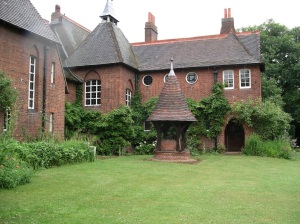For this writing prompt, I was to write about 500 words on a place of some kind. It ties into the discussion of psychogeography, which you may have noticed is a recurring idea throughout this blog. Again, it’s the Alan Moore model, so maybe I’m way off in my understanding.
I know the suburbs and the high streets; I know the dull chrome arclights, the flowered fountain, the clock tower and its ring of busts, all seagreen and pock-marked with pigeon. I have spent most of my adolescence there, going to the library, kicking around parks, getting fish and chips from the same café my mum used to work at as a teenager. I’m following old paths like surface memory, cut out by many urbanites before me, because really, why go anywhere else? What else does Bexleyheath have to offer?
Look harder. South of Danson Park, you can almost see it. A slit, a scar, a crack in the skin of ash and smoke, cracking open as it snakes across Bean Road until it peels away and… there! Tudor in spirit, Gothic in design, all cross gables and sloping roofs, bricks the colour of decaying iron. The grass becomes greener, the clouds pristine and fluffy, and you’d swear roses have started to bloom, heralds of the older Bexleyheath.
In Bruges, William Morris dreams of an older England, his Guinevere sleeping gently between wrinkled sheets of Sea island cotton. He dreams of an England captured in paint and oils, where the world can be translated to canvas, blemishes and flaws dying in the transition; a photograph of the England that should have been. He will build his old-new England in Kent. The brave new world begins only a short distance and six hundred and eighty-six years away from where pilgrims travelled to Becket’s shrine in Canterbury, tracing a path carved out in the Stone Age. Kent is a palimpsest, new lines written over old etchings, Morris and the pilgrims seeking and following ghosts.
He chooses Upton, three miles from the skeleton of an abbey and three miles from the railway station that will take him into London. He regards London as a tiger, fascinated and yet fearful of its splendour. He nervously glances at Brunel’s infernal machines as they hack and cough soot and coaldust into the sky, watches the countryside become increasingly tattooed with rail tracks. His discomfort is shared by Dante Gabriel Rossetti, forever in the whirlwind throes of Arthurian romance, the once and future Lancelot. Soon they find their brothers: Ford Madox Brown, Edward Burne-Jones, Arthur Hughes, fellow knights seeking Camelot.
Morris and Rosetti and Siddal have all gone. Bexleyheath is swallowed by London nearly a century later. But there, on the other side of the bite mark where the Council tore into Kent, there is the Red House, a spell captured in tile and mortar. It is here where the old Bexleyheath sleeps beneath Greater London, and dreams of a new Camelot, the Red King in redbrick.
